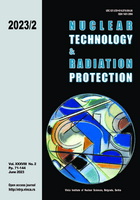
ESTIMATION OF TRITIUM GENERATION AND DISCHARGE OF THE AP1000 REACTOR BASED ON HISTORICAL DISCHARGE DATA FROM THE U.S. PRESSURIZED WATER REACTORS

Vol.
XXXVIII, No. 2, Pp. 71-144
June 2023
UDC 621.039+614.876:504.06
ISSN 1451-3994
Pages: 80-87
Authors: Qi WangAbstract
During the normal operation of pressurized water reactors, tritium has contributed more than 95 % of the total radioactivity of all the radionuclides discharged into the environment and has been recognized as the key radionuclide in the design and operation of reactors. In the paper, the tritium production of the AP1000 reactor by the Westinghouse approach has been introduced and the diffusion fractions of tritium from fuel rods in the approach have been reviewed according to advances in research on the diffusion of tritium from zirconium alloys. The historical tritium discharge data from the predecessors with very similar core designs of the AP1000 reactor have been collected and sorted. According to the statistical results, the average tritium discharge approximates the tritium generated from neutron activation of boric acid and lithium hydroxide and it shows that the release fraction of tritium through fuel cladding with zirconium alloy may be neglected for the best-estimated condition. The release of tritium from secondary neutron sources has been validated by a comparison of historical tritium discharge from the predecessors with and without secondary sources. In addition, it indicates that local maximum tritium emissions from the U.S. Pressurized Water Reactors are remarkably affected by batch liquid release, especially before or during the overhauls. It will help recognize the tritium generation in the primary loops and optimize the management of radioactive emissions for the utilities of the AP1000 reactor in the future.
Key words: tritium, discharge, AP1000, pressurized water reactor
FULL PAPER IN PDF FORMAT (1.03 MB)